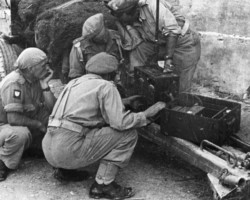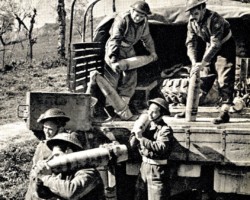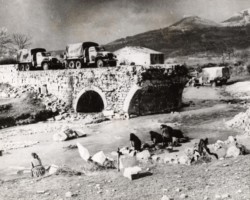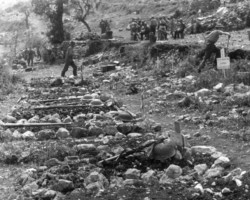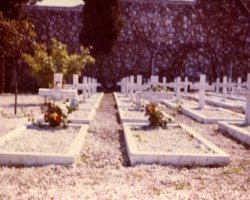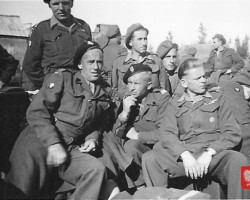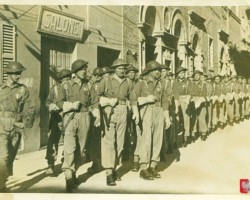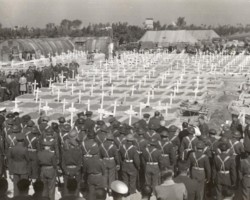Italian Campaign
Prof. Dr. Hab. Zbigniew Wawer
On November 10, 1943, the commander of the Allied 15th Army Group, General Alexander, decided that due to the British organization and equipment, the 2nd Polish Corps would be part of the British 8th Army commanded by General Bernard Montgomery when sent to Italy. Since the 3rd Carpathian Rifle Division (3rd Carpathian Rifle Division) had been trained for mountain warfare, it would be sent first to the section of the 8th Army front on the Sangro. General Alexander would be very pleased if the 2nd Corps could enter action north-east of Orvieto. The commander of the 15th Army Group hoped that by the time the entire 2nd Corps arrived in Italy, the 8th Army units would have reached the Orvieto–Ancona line.
On November 25, the Commander-in-Chief, General Kazimierz Sosnkowski, who was in the Middle East, issued guidelines for the organization of the APW in connection with the planned departure of the 2nd Corps to the front. The army was divided into three echelons. The first of them was the 2nd Corps together with the Corps Base. According to the guidelines of the Commander-in-Chief, it was an “independent tactical and operational unit operating within the British Army in the theatre of war.” The first echelon was commanded by General Anders, the commander of the APW, who was also the commander of the 2nd Corps.
On December 7, at his Field Headquarters, General Wilson met with General Sosnkowski and Anders. During the meeting, issues related to sending the 2nd Corps to Italy and the reorganization of the APW were raised. At the end of the meeting, General Sosnkowski and General Anders were acquainted with the plan for transporting Polish units from Egypt to Italy. From December 1943 to February 1944, the transfer of the 2nd Corps to the Italian front took place.
On January 12, 1944, the Battle of Rome, also known as the Battle of Monte Cassino, began. The first three battles ended in failure and the German positions in the Monte Cassino massif were not broken through.
On 26 January, the 2nd Corps became part of the British 8th Army. After a short concentration, Polish units were moved to the front line on the Sangro. The 3rd Carrier Cavalry Division was the first to go into action, followed by the remaining units of the Corps. Due to the season, combat operations were limited to patrols’ raids on advanced German positions.
For descriptions of the battle, see the text – The Battle of Monte Cassino
Ancona
After the Battle of Monte Cassino, the 2nd Corps was transferred to the reserve of the 8th Army. The further Allied offensive on the Italian peninsula had taken the main supply port at Pescara on the Adriatic too far from the battlefield. The Allies therefore needed new ports through which to deliver war material. The choice fell on Ancona on the Adriatic and Livorno on the Tyrrhenian Sea.
On June 16, General Anders received an order: “The 2nd Polish Corps is to pursue the enemy as quickly as possible and capture Ancona.” On June 21, the 1st Carpathian Rifle Brigade of the 3rd Carpathian Rifle Division reached the Chienti River. Two days later, the 2nd Carpathian Rifle Brigade reached the river. Fighting in this area lasted until June 30.
When planning the Ancona operation, General Anders assumed that German operations on the Adriatic would depend on the development of the situation in central Italy, where the main Allied attack was being conducted. In connection with this, the commander of the 2nd Corps assumed two variants of future operations: German units would put up fierce resistance in the Ancona area; the enemy, seeing no chance of defending the Ancona area, would put the main emphasis on organizing a defence on the Gothic Line. As part of the operation, the 5th Kresowa Infantry Division (5th KDP) was to be used to deeply bypass the German defence from the west in the Ancona area and “cut it off on the Esimo River”. The main task was to be carried out by the 5th Kresowa Infantry Division and the 2nd Armored Brigade. In case of enemy resistance in the area of Ancona, the 3rd Carpathian Division, reinforced with the 11th Heavy Artillery Regiment and the 1st Krechowiecki Uhlan Regiment, was to lead an attack along the sea coast and engage the enemy from the south, “whereas after establishing contact with the enemy’s defense in the area of Ancona, the actions of [the 3rd Carpathian Division] should manifest the main effort on its left wing in order to bypass the defense and cooperate with the 5th Carpathian Division.”
On July 17, the 2nd Corps began its attack on Ancona. The capture of M. dellaCrescia by the 15th Battalion of the 5th KDP allowed the 2nd Armoured Brigade to make a flanking manoeuvre and get to the rear of the German units defending Ancona. That day, the units of the 6th Lvov Infantry Brigade reached the Esino River, capturing the town of Chiaravalla, where a bridgehead was established. At the same time, the 2nd Armoured Brigade reached the sea. Ancona was cut off from the north-west.
When the fate of the operation was being decided in the sector of the 5th KDP, General Anders ordered the pursuit of the 3rd Carpathian Cavalry Regiment, which until then had been “holding its sector passively”. The pursuit was very fast. The enemy offered no resistance, retreating towards the sea. On July 18 at 2:30 p.m. the Carpathian Uhlan Regiment entered Ancona.
The Battle of Ancona was the only independent operation of the Polish Armed Forces in the West during World War II. Thanks to the capture of the port, the deliveries of war materials to the Allied forces advancing along the Adriatic coast were significantly shortened.
The losses of the 2nd Corps from 15 June to 24 July 1944 amounted to: 496 killed in action, 1,789 wounded and 139 missing.
In the final phase of the Battle of Ancona, General Anders began preparations for an attack on the Gothic Line. The plan of action of the Polish Corps in this operation was presented to General Anders by the commander of the 8th Army, General Leese. As part of the operations on the “Gothic Line”, the 2nd Corps was tasked with: “pushing the enemy back as quickly as possible across the Metauro River, i.e. to the direct foreground of the “Gothic Line”. At the Metauro River, prepare the initial bases for the attack for the 8th Army. Take an active part – alongside other Corps of the 8th Army – in breaking through the fortified position of the Gothic.”
On August 5, the 3rd Infantry Division reached the Cesano River, where it encountered strong enemy resistance, and on August 22, it reached the Metauro River. At the turn of August and September 1944, the units of the 2nd Corps broke through the forward edge of the “Gothic Line”.
Emilian Apennines
In mid-October, the 2nd Corps was once again sent to the front in the Emilian Apennines. Polish units were tasked with covering the western wing of the 8th Army, operating along the No. 9 road from Ancona towards Bologna. The operations were divided into two phases. In the first phase, the 5th KDP was to take over the hills of M. Grosso and MS Pietro, thus enabling the deployment of the entire Polish Corps. In the second phase, the 2nd Corps, together with units of the 8th Army, was to attack Forli.
The battlefield in which the units of the 2nd Corps were to operate was very difficult to overcome. The terrain conditions in this part of the Apennines were described in the “2nd Corps War Operations Bulletin” as follows: “The mountains are wild, jagged, with large differences in relative height. There are many sharp peaks, slopes that break off abruptly with almost vertical slopes – up to 70 degrees of inclination, narrow ridges and sharp edges where mule can barely pass. The slopes are generally steep, with few gentle slopes – even in the enemy’s rear. The road, suitable for motor traffic, is very sparse. There are numerous serpentines and sharp descents, especially troublesome during the rains prevailing at this time of year. The basic type of communication route is a narrow mule path. These paths were very slippery, so there were cases of mules and even soldiers falling into the abyss.”
The 5th Infantry Brigade was the first to enter the action, tasked with capturing a road junction in the Galeata area. The main task fell to the 5th Vilnius Infantry Brigade, supported by a squadron of the 4th Armoured Regiment. By 20 October, the group had captured S. Sofia, Galeata and M. Grosso and had gained a bridgehead on the Rabbi River, driving a wedge between two German divisions. On 25 October, the 18th Battalion captured the town of Predappio, Mussolini’s birthplace.
The attack of the 5th KDP at the junction of the 305th and 356th Infantry Divisions came as a big surprise to the German command. According to the commander of the 8th Army, “it had a serious impact on the general position on the front of this Army”. Thanks to the success of the attack of the 5th KDP, the enemy had to abandon the defence of the Savio River. This made it easier for the Canadian I Corps and the British V Corps to attack towards Forli. On the other hand, taking control of the M. Mirabello – M. Colombo hills allowed the 2nd Corps to occupy convenient starting points for further attack.
On October 25, General Anders was tasked with cutting the No. 9 road between Forli and Faenza. In mid-November, the 3rd Carpathian Division, after heavy fighting in pouring rain, threatened the southern flank of the German defence in the Forli area. The first phase of the 2nd Corps’ fighting enabled British troops to capture an important road junction in the Forli area.
On November 26, the 3rd Infantry Division reached the outskirts of Faenza, and eight days later it broke through the enemy’s defences on the Lamone and Sintria rivers, reaching the Senio River.
On November 9, the commanders of large units met at the 2nd Corps headquarters. Gen. Anders, discussing the situation on the front, informed the audience that as a result of the German counterattack southwest of Faenza, “there was a danger that the V Corps units would be thrown across the river.” This would allow the enemy to get to the rear of the 46th Infantry Division, and could then threaten the 3rd Infantry Division. Therefore, Gen. Duch should take countermeasures as soon as possible. After the 3rd Infantry Division took control of the designated objects, the first echelon of the 5th Infantry Division command was to move to Brisighella.
The losses of the 2nd Corps in the Emilian Apennines were: 269 killed, 1,123 wounded.
Reinforcements of the 2nd Corps
In mid-1944, the 2nd Corps Staff prepared a plan to expand the 2nd Corps with: two infantry brigades, one motorized infantry brigade for the armoured division that was to be formed, one armoured brigade in Egypt, one heavy artillery regiment and two medium artillery regiments for the 2nd Army Artillery Group, one light artillery regiment for the armoured division, and weapons and service units.
On September 30, General Anders issued guidelines for the reinforcement and expansion of the 2nd Corps. The first phase of expansion was to be completed on February 1, 1945. Three infantry brigades were to be formed during this period. On October 17, in accordance with the decision of the Commander-in-Chief and General Anders’ guidelines regarding the expansion plan for the 2nd Corps, orders were issued to create the 3rd Carpathian Rifle Brigade for the 3rd Carpathian Rifle Division and the 4th Kresowa Infantry Brigade for the 5th Kresowa Infantry Division.
By January 8, 1945, the ranks of the 2nd Corps had been bolstered by 26,904 soldiers, of whom about 4,000 had replaced the Corps’ combat losses. Most of them were Poles forcibly conscripted into the German army.
Sounds of Yalta in the 2nd Corps
On February 11, the conference of the Big Three ended in Yalta. It was then that Poland was treacherously sold to Stalin by the Western Allies. The following day, General Anders participated in a meeting in Florence with General George Marshall, who had stopped in Italy on his way back from Yalta. When asked by General Anders whether the Polish issue had been discussed at Yalta, the American general gave an evasive answer. On the evening of February 12, a communiqué on the decisions of the Yalta conference was announced in London, Washington, and Moscow. In the fragment concerning the Polish eastern border, the leaders of the three powers decided that it should run along the Curzon Line. This caused a shock in all units of the Polish Armed Forces in the West. The surrender of the Eastern Borderlands to the Soviets had a wide echo among the units of the 2nd Corps, where many soldiers from these lands served. The situation became tense.
On February 13, the Polish government in London protested against the fifth partition of Poland. That day, General Anders wrote in a telegram to President Władysław Raczkiewicz: “In view of the tragic communiqué of the last conference of the three, I report that the 2nd Corps cannot recognize the unilateral decision to surrender Poland and the Polish nation to the Bolsheviks.
I have asked the allied authorities to withdraw the Corps units from combat sectors. I do not have the conscience to demand a blood sacrifice from a soldier at this time.” At the same time, the commander of the 2nd Corps sent a letter to the commander of the 8th Army, in which he wrote, among other things: “I see the need to immediately relieve the units of the 2nd Polish Corps from the combat sector. […] in view of the fact that neither I nor the commanders subordinate to me could find in their conscience a justification today for demanding new sacrifices from the soldiers of the 2nd Polish Corps.”
On February 14, the Government of the Republic of Poland issued an appeal to the soldiers of the Polish Armed Forces in the West, calling on them to maintain calm and maintain further brotherhood in arms with English, American, Canadian and French soldiers.
On February 15, General Anders met with General MacCreery at the 8th Army field headquarters to discuss the withdrawal of Polish units from the front. The commander of the 8th Army informed General Anders that, for operational reasons, there was no possibility of withdrawing the 2nd Corps, as there was no one to replace it. Over the next few days, the commander of the 2nd Corps met with General Clark and Marshal Alexander. The latter “appealed for patience and asked General Anders not to order any changes. He considered that it would not be decent to demand that the Polish Corps take active action and assured that he would only demand that it hold the sector entrusted to it.”
Yalta had the greatest impact on the units of the 5th Kresowa Infantry Division commanded by General Nikodem Sulik. During this difficult period, General Anders issued a proclamation to all soldiers of the Corps, in which he wrote: “we have been through all the difficult moments so far together, I have experienced all the ups and downs with you. And today I believe that God the Most High will allow the Polish Nation and Soldiers to survive the current most difficult period and overcome all the adversities that are piling up before us on the road to a Free and Independent Poland. I, as your commander, will do everything to ensure that your conduct is such as the good of the Fatherland and the honour of the Nation require. Always remember that the harder it gets, the more we need to be consistent, disciplined, calm and have faith in our hearts.”
On February 15, the commander of the 2nd Corps was summoned to London by President Władysław Raczkiewicz, but for political reasons General Anders could only fly out five days later.
On February 21, General Anders was received by Prime Minister Winston Churchill. During the meeting, the British leader, responding very violently to the Polish general’s opinions regarding the Yalta conference, said: “You are to blame for this. I have long been urging you to settle the issue of the borders with Soviet Russia and to give it the lands east of the Curzon Line. If you had listened to me, the whole matter would look different today. We have never guaranteed Poland’s eastern borders. We have enough troops today and do not need your help. You can take your divisions. We will do without them.” General Anders replied: “You have not said that for the last few years. We still want to fight, but for a free and independent Poland. Russia has no right to our territory, which it has never questioned. It has broken all agreements and seized these lands at the time under the terms of the agreement and alliance with Hitler.”
On February 26, General Anders took over as acting Commander-in-Chief. This was due to the fact that at that time the Commander-in-Chief, General Tadeusz Bór-Komorowski, was in German captivity. The following day, a debate on Polish affairs was held in the House of Commons. The so-called amendment on the Polish issue, submitted by a group of members of the House of Commons to express regret: “due to the surrender of the territory of an allied country to a second power in violation of Article 2 of the Atlantic Charter”, was rejected by 396 votes to 25.
Battle of Bologna
The 2nd Polish Corps, before the start of the spring offensive on the Italian front, consisted of the 3rd Carpathian Rifle Division, the 5th Kresowa Infantry Division, the 2nd Warsaw Armoured Brigade, the 2nd Artillery Group, the 2nd Corps Base and many units of corps services and weapons. The strength of the 2nd Corps units in the first line amounted to 55,780 soldiers. In connection with the planned “BUCKLAND” operation, the Polish Corps was reinforced by the British 7th Armoured Brigade, the Indian 43rd Motorised Infantry Brigade and several British artillery regiments.
The acting commander of the 2nd Corps, General Zygmunt Bohusz-Szyszko, attached great importance to supporting the attack with artillery in the planned operation. In studies on the Battle of Bologna, it was called the largest battle of Polish artillery in World War II.
Before the battle, the commander of the 15th Army Group assigned tasks to the subordinate armies. Thus, the 8th Army, after capturing bridgeheads on the Santerno River, was to operate towards Ferrara in close contact with the operation of the 5th Army towards Bologna.
On April 9, General Władysław Anders arrived at the advanced command post of the 2nd Corps to take over the Commander-in-Chief. The Polish attack was preceded by an Allied bombardment. 175,000 20-pound bombs were dropped on the first line of German defence on the Senio River. During the raid, one of the waves of Allied bombers mistook the designated area and bombed the positions of the 2nd BSK, whose battalions were preparing to attack.
At 19:20 the attack began. Since the New Zealand 2nd Infantry Division held the western bank of the Senio River, it was the first to cross the river and push forward. The 3rd Carpathian Cavalry Division and the Indian 8th Infantry Division had to capture the western bank in the first phase of the action and only then start to cross the Senio.
On April 10, the “RUD” Group, commanded by General Klemens Rudnicki, occupied the eastern rampart of the Senio River and began operations towards the Santerno River. Between the Senio and Santerno Rivers, the enemy left strong covering units, which put up fierce resistance in the towns of Salarolo and Nuovo. At dawn on April 12, the “RUD” Group occupied Castel Bolognese. Throughout the day, the battalions of the 3rd DSK fought to break through the German positions on the Santerno River.
On April 14, the 5th KDP Groups entered the action. The action began with breaking through the German defence on the Santerno River in the direction of SassoMorelli. The opponent of the 5th KDP was the German 4th Parachute Division. The most important event of that day was the capture of Imola by the “RUD” Group. On the night of April 14-15, the 6th Lviv Infantry Brigade (6th LBP) reached the Sillaro River.
On April 16, the German command introduced the 1st Parachute Division into the fight on the section of the 5th KDP Group’s advance, while the German 26th Panzer Division was withdrawn towards Medicina, leaving tanks and guns at the disposal of the 278th Infantry Division. On that day, the “RAK” Group of General Bronisław Rakowski and the 6th LBP Group reached the Medicina canal. The following day, the 8th Army command issued instructions for further attack. In this phase of the battle, the 2nd Corps was to occupy bridgeheads on the Idice River in order to cover the left wing of the 8th Army and was to be prepared for operations on Bologna.
The next morning, the 43rd Gurkha Brigade, operating on the right flank of the 5th KDP, crossed the Gaiana River. However, as a result of a German counterattack by the 1st Parachute Division, the Brigade was pushed back across the river.
Analyzing the information about the enemy coming from the foreground, the commander of the 5th KDP expected strong German resistance on the line of the Gaiana River. Gen. Sulik intended to carry out the task assigned by the commander of the 2nd Corps: crossing the Gaiana River and further pursuing the enemy in three phases: in the first, to cross the river and create a bridgehead; in the second, with two battalion groups operating on two axes, to reach the Quaderna River; in the third, to organize a bridgehead on this river.
On April 19, the crossing of the Fossatone Canal by the 5th KDP forces forced the enemy to abandon their positions on the Gaiana River and retreat westward. There were still strong German forces on the river, which had not received the order to withdraw.
The description of the operations prepared by the Staff of the 5th KDP stated: “In the evening of April 19, a crisis of the battle emerged. Losses on both sides were significant. The scales of victory tilted in our favour. If the enemy remained, finishing him off was planned by a normal attack on April 20 from the morning. […] The intention of the commander of the 5th KDP Group was to maintain contact at all costs and pursue the enemy if he withdrew – however, he did not see the possibility of continuing the attack at night, in terrain difficult to use tanks, with tired and bloodied units.” For example, the 1st Krechowiecki Uhlan Regiment supporting the attack of the 5th Division was unable to continue operating without a break at night.
At first, General Sulik wanted to continue the pursuit, so he asked the 2nd Corps Staff to assign a fresh armoured regiment. However, the 2nd Corps command did not want to use up the forces they still had, expecting a battle on the Idice River. Therefore, at 8:00 p.m., General Sulik decided to: “stop further attack, organize the units, maintain contact with neighbors, clear the occupied area and be ready for further action at dawn.”
Bologna was outside the 2nd Corps’ operational belt and was the target of the American 5th Army’s attack. Only after crossing the Gaiana River did the commander of the 8th Army change the direction of the Polish attack from west to north-west. General Bohusz-Szyszko, fearing that the Germans defending this important communication junction could attack the unprotected flank of the attacking Polish units, decided to send the “RUD” Group towards Bologna.
On April 20, General Bohusz-Szyszko issued orders ordering the pursuit of the enemy the following day. The “RUD” group (3rd Carpathian Rifle Brigade) was tasked with taking control of Bologna. At 7 p.m., General Rudnicki arrived at the command of the 3rd Brigade and gave Colonel Gustaw Łowczowski the order to pursue the enemy in order to reach the S. Sisto–S. Donino–S. Donato line and to send a battalion group to Bologna to eliminate German resistance points in the city and hang the Polish flag. The main task was to be carried out by the 8th and 9th Battalions, supported by other units. The commander of the 9th Battalion, Major Leon Firczyk, was to assign a special unit under the command of Major Józef Rożański with the task of clearing the city. The chaplain of the 3rd Brigade, Fr. Rafał Grzondziel, who took on the duty of interpreter. “When the head of the 4th company reached the board with the inscription “BOLOGNA”, the last platoon of the 3rd company was approached by a German company coming from the south. The Germans emerging from behind the fog were first noticed by Rifleman Franciszek Wohler and Rifleman Panach, who immediately opened fire with their light machine guns and Thomson. The platoon (Second Lieutenant Bogumił Witkowski) quickly deployed, after which a firefight also with grenades ensued. 28 prisoners were taken, the rest escaped, leaving 3 dead and 5 wounded. […] After entering the city, the companies advanced on both sides of the streets under the houses. Near the “Brigata Nera” barracks, the companies received machine gun fire from the windows of the building, several bursts fired at the windows restored peace. Soon the character of the march was completely transformed. The soldiers marched surrounded by a mass of cheering civilians and showered with flowers. The square in front of the town hall where the companies stopped was filled with crowds of people.
Major Rożański and Father Capt. Grzondziel entered the building and there, in the council chamber, the city council gave them the building at their disposal. After hanging a white-red banner from the balcony, Father Grzondziel spoke in Italian to those gathered in the courtyard: Poles bring you freedom. We want peace and order to reign in the city. Long live free Italy! Long live Bologna! In response, shouts rose from the crowd: “Long live Poland! Long live the Poles!
The indefatigable Fr. Grzondziel now hurried to the city’s highest tower, Torre Asinelli, to hang the second Polish banner there. It was 6:15 a.m. on April 21, 1945.”
The report of the 9th Battalion’s entry into the city and the Americans’ advance warning brought joy to the 8th Army command.
At 8:00 a.m. American tanks reached the city centre. Their commander was surprised that the city had already been taken over. Soon after them, Italian partisan units appeared. “In front of the city hall, the companies of the 3rd and 4th – 9th Battalion stood in even rows, the soldiers’ faces were smiling, joy radiated from their reddened eyes. Everyone congratulated them and probably everyone thought and regretted that they had won the gratitude of the welcoming Bologna, and not Krakow, Cieszyn or Sącz. If only flowers from Polish meadows, thrown by the hands of Polish children and Polish girls, had been showering them! However, fate had decreed otherwise. A golden book of the city was displayed in the city hall with a request for all arriving commanders to sign it. The mayor of the city, Giuseppe Dozza, sent a letter:
“To the Commander of the Unit of Polish Liberators!
Mr. Commander! In the name of the entire population of the city, I greet the Polish Liberation Troops who were the first to enter Bologna at dawn on that great day. The triumphant enthusiasm with which the city’s inhabitants welcomed your brave troops tells you what the feelings of the Bolognese are, who feel they are allies among the allies. I ask you to convey these words of mine to the Polish soldiers, our friends, with whom the Bolognese feel connected by the common bonds of freedom, which has linked the history of Poles and Italians for centuries. LONG LIVE POLAND!
On April 22, the units of the 2nd Corps were stopped in their further pursuit of the enemy and moved to the reserve of the 8th Army. In the Battle of Bologna, the losses of the 2nd Corps amounted to 234 killed and 1,228 wounded.
On April 23, the actions of the 5th and 8th Armies led to the meeting of units of both Armies north of the Reno River, which closed the retreat of the German forces in that area. On that day, the Indian 8th Division of the V Corps reached the Po River. The defeat of the German forces in northern Italy was a fact.
Exhibition Materials




